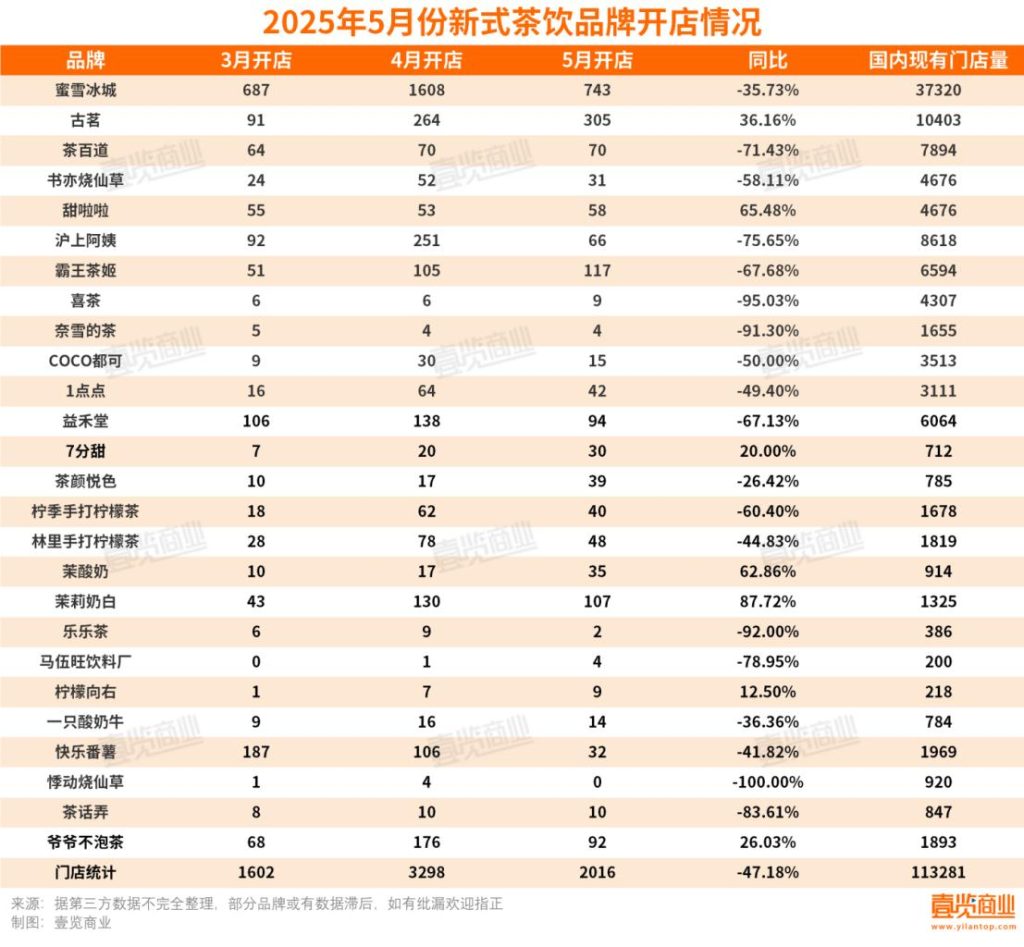
Positive Reviews: The New Tea Drink Industry Enters a New Phase of “Refined Operation”, with Scale, Innovation, and Rational Marketing Sending Positive Signals
In May 2025, the data of the new tea drink industry released multiple positive signals, indicating that after a period of rapid expansion, the industry is gradually shifting to a new phase characterized by “quality first, innovation-driven, and rational growth”.
Firstly, the scale effect of leading brands and the vitality of regional brands form a “dual – wheel drive”, making the industry ecosystem healthier. Guming officially entered the “10,000 – store club” (with 10,403 existing stores), becoming the second new tea drink brand after Mixue Bingcheng to exceed 10,000 stores. A scale of 10,000 stores not only means the maturity of the supply chain and brand power but also can reduce the cost per store through the scale effect and enhance the risk – resistance ability. Guming added 305 new stores in May, a year – on – year increase of 36.16%. The stability of its expansion pace confirms the sustainability of large – scale operation. Meanwhile, regional brands such as Cha颜Yuese, Happy Sweet Potato, and Lemon Right demonstrated the characteristics of “small – scale but high – energy”. Relying on local flavor adaptation and precise customer group positioning (such as targeting the sinking market or being bound to regional culture), they rapidly penetrated into niche markets. This pattern of “leading brand scale + regional in – depth cultivation” avoids the over – concentration of industry resources, provides consumers with diverse choices, and leaves room for small and medium – sized brands to survive.
Secondly, product innovation has shifted from “competing in product categories” to “competing in raw material culture”, and differentiated competition has entered a deeper level. In May, 26 brands launched a total of 105 SKUs, 17 more than in April, and the enthusiasm for product R & D continued. Notably, in addition to mainstream fruits such as peaches and bayberries (7 brands launched peach products and 4 launched bayberry products), brands began to explore niche raw materials. The “Anthocyanin Aronia” series of Shu Yi Shao Xian Cao emphasized the health – function attributes, and Cha Baidao introduced the southwest – characteristic “Wild Litsea cubeba”, integrating regional culture and wild aesthetics. This kind of innovation is not only a breakthrough in taste but also a deep exploration of the “value of raw materials”. By endowing raw materials with cultural stories (such as regional characteristics and health benefits), brands can create more lasting user memory points and avoid falling into the trap of “homogeneous blockbusters”. For example, as a niche spice in the southwest region, the unique flavor and “wild” label of wild Litsea cubeba can precisely attract young consumers who pursue novel experiences. This differentiated strategy has higher barriers than simply replicating mainstream fruits.
Finally, the marketing model has shifted from “creating a stir” to “practical results”, and brands pay more attention to the return on investment (ROI) and private – domain precipitation. In May, the number of co – branding activities dropped to the lowest in the past three months (only 5 brands participated), while celebrity endorsements and KOL promotions (7 brands participated) became new tools. This change reflects the industry’s reflection on the “marketing bubble”. In the past, brands relied on IP co – branding to create topics, but some activities only stayed at the level of “going viral” with limited actual sales conversion. Now, brands are more inclined to directly reach target users through the fan effect of celebrities/KOLs, shortening the link from “content promotion – purchase conversion”. In addition, Mixue Bingcheng and Linli Lemon Tea insist on in – depth cultivation of their own IPs, strengthening user recognition through peripheral products. This “long – term” marketing strategy can accumulate brand visual assets and reduce the dependence on external IPs. Overall, the “rational return” of marketing means that the industry has shifted from “traffic competition” to “user management”, paying more attention to private – domain traffic precipitation and repurchase rate improvement, which is crucial for the long – term value construction of brands.
Negative Reviews: There are still Hidden Concerns in the Industry, including Differentiated Store Expansion, Product Homogeneity, and Challenges in Marketing Transformation
Although the industry shows positive trends, the data in May also exposed multiple hidden concerns, and potential risks under the “superficial prosperity” need to be vigilant.
Firstly, the differentiation of store expansion among leading brands has intensified, and some brands are facing the “scale trap”. Guming’s breakthrough of 10,000 stores is in sharp contrast to Cha Baidao’s “net reduction of 104 stores”. Cha Baidao added 70 new stores in May, but the net number of stores decreased to 7,894, indicating that its store – closing rate has exceeded the store – opening rate.沪上阿姨 only had a net increase of 13 stores, and its expansion pace slowed down significantly. This differentiation may be due to two reasons. One is market saturation, especially in first – and second – tier cities, where the density of new tea drink stores has almost reached the ceiling, and new stores are difficult to make a profit. The other is that some brands expanded too fast in the early stage, and their management capabilities did not improve synchronously, resulting in a decline in the operation quality of single stores (such as a lagging supply chain and insufficient staff training), and finally being forced to close stores. If leading brands fall into the vicious circle of “expansion – store closing”, it may trigger an industry trust crisis and affect the confidence of investors and franchisees.
Secondly, product innovation still cannot get rid of the “fruit dependence”, and the risk of homogeneity still exists. Although the exploration of niche raw materials is a highlight, the mainstream of new product launches in May still focused on popular fruits such as peaches, bayberries, apples, and watermelons (a total of 18 brands launched products around these fruits). This “crowded” innovation is likely to cause consumer aesthetic fatigue. For example, peach tea drinks have been the “top – selling” products in summer for many years, and their novelty is fading. If brands only make minor adjustments on the basis of “fruit + tea base” without breakthroughs in taste levels (such as the way of processing fruit pulp and tea base blending) or scenario adaptation (such as smoothie and cold – brewed tea), they will eventually fall into the homogeneous competition of “you have peaches and I have bayberries”. In addition, the commercialization risk of niche raw materials is relatively high. The supply – chain stability (such as yield fluctuations and cost control) and consumer acceptance (such as whether the taste is “too niche to be popularized”) of raw materials like wild Litsea cubeba and anthocyanin aronia need to be verified. If the market feedback is not as expected, it may lead to a waste of R & D investment.
Thirdly, there are both “uncertainty in effectiveness” and “cost pressure” in marketing transformation. Although celebrity endorsements and KOL promotions can directly reach users, the cost is much higher than that of IP co – branding. The endorsement fee of top – tier celebrities can reach tens of millions, and the promotion fees of mid – tier KOLs have also increased with the industry demand. If brands rely too much on this “heavy – investment” model, it may squeeze the profit margin. In addition, the “persona risk” of celebrities (such as negative news) and the “traffic bubble” of KOLs (such as fake fans and data fraud) may also backfire on brands. The in – depth cultivation of self – owned IPs requires long – term investment. Mixue Bingcheng’s “Snow King” IP took many years of operation to form strong recognition. If new brands are eager to copy it, they may not succeed due to the lack of cultural accumulation. Although the “rationalization” of the marketing model is worthy of recognition, how to balance “short – term conversion” and “long – term brand building” is still an issue to be solved in the industry.
Advice for Entrepreneurs: Focus on “Quality, Differentiation, and Precision” to Break Through in Refined Operation
Facing the trends of “differentiated expansion, in – depth innovation, and rational marketing” in the industry, entrepreneurs need to adjust their strategies in the following three aspects:
-
Store Expansion: Shift from “Quantity First” to “Quality First” and Focus on the Single – Store Profit Model
Avoid blindly pursuing the store – opening speed. It is necessary to focus on evaluating the consumption density of the target area (such as the pedestrian flow in commercial areas and the distribution of competitors), the supply – chain coverage ability (such as the delivery time of raw materials), and the cost structure of single stores (such as rent and labor). Entrepreneurs can learn from Guming’s “stable expansion” strategy: reduce the delivery cost through regional dense layout and ensure the service quality of stores through standardized training. For regional brands, they can focus on the “small but beautiful” model, deeply cultivate local customer groups (such as designing products combined with local dialects and folk customs), and build a “regional mental” barrier. -
Product R & D: Balance “Mainstream Demand” and “Differentiated Innovation” and Build Raw Material Stories
Mainstream fruits (such as peaches) are still the key to attracting traffic in summer, but breakthroughs need to be made in “details”. For example, optimize the size of fruit pulp particles to improve the taste, or endow products with a sense of ritual by combining with seasonal scenarios (such as “Dragon Boat Festival limited” and “camping special blends”). The selection of niche raw materials should take into account both “uniqueness” and “accessibility” (such as choosing regional – characteristic raw materials with a mature supply chain), and strengthen their cultural value through content marketing (such as shooting documentaries about the origin of raw materials and inviting users to participate in picking experiences), so that “niche” becomes the brand’s differentiated label. -
Marketing Investment: Shift from “Broadcasting Widely” to “Precise Targeting” and Attach Importance to Private – Domain Precipitation
Reduce inefficient co – branding and give priority to choosing IPs that highly match the brand’s tone (for example, tea drink brands can co – brand with national – style cultural and creative products rather than cross – field brands). When it comes to celebrity endorsements, evaluate the overlap between the “fan profile” and the target customer group (for example, idols preferred by Generation Z are more suitable for youthful brands). For KOL cooperation, focus on “vertical – field influencers” (such as fruit tea – making bloggers and local – life bloggers) to improve the conversion efficiency. At the same time, precipitate private – domain traffic through membership systems and community operations (such as welfare groups and new – product tasting activities) to improve the user repurchase rate. The LTV (lifetime value) of private – domain users is usually 2 – 3 times that of public – domain users, which is the key to long – term profitability.
Overall, the new tea drink industry has entered the value – competition stage of “intensive cultivation” from the wild – growth stage of “seizing territory”. Entrepreneurs need to take “quality” as the foundation, “differentiation” as the weapon, and “precision” as the strategy to break through in the stock market and achieve sustainable growth.




